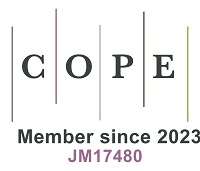REFERENCES
1. Boehm S, Jeffery L, Levin K, et al. State of climate action 2022. Available from: https://climateanalytics.org/publications/2022/state-of-climate-action-2022 [Last accessed on 2 Aug 2024].
2. Climate Action Tracker. CAT net zero target evaluations. 2022. Available from: https://climateactiontracker.org/global/cat-net-zero-target-evaluations [Last accessed on 2 Aug 2024].
3. Igarashi Y, Daigo I, Matsuno Y, Adachi Y. Dynamic material flow analysis for stainless steels in Japan-reductions potential of CO2 emissions by promoting closed loop recycling of stainless steels. ISIJ Int 2007;47:758-63.
4. Krausmann F, Lauk C, Haas W, Wiedenhofer D. From resource extraction to outflows of wastes and emissions: the socioeconomic metabolism of the global economy, 1900-2015. Glob Environ Chang 2018;52:131-40.
5. Liu GX, Wu M, Jia FR, Yue Q, Wang HM. Material flow and spatial data analysis of the petroleum use to carbon dioxide (CO2) emissions in Northeast China. J Ind Ecol 2019;23:823-37.
6. Li D, Shen L, Zhong S, Elshkaki A, Li X. Spatial and temporal evolution patterns of material, energy and carbon emission nexus for power generation infrastructure in China. Resour Conserv Recycl 2023;190:106775.
7. Bruckner M, Giljum S, Lutz C, Wiebe KS. Materials embodied in international trade - global material extraction and consumption between 1995 and 2005. Glob Environ Chang 2012;22:568-76.
8. Chowdhury R, Zhang X. Phosphorus use efficiency in agricultural systems: a comprehensive assessment through the review of national scale substance flow analyses. Ecol Indic 2021;121:107172.
9. Müller E, Hilty LM, Widmer R, Schluep M, Faulstich M. Modeling metal stocks and flows: a review of dynamic material flow analysis methods. Environ Sci Technol 2014;48:2102-13.
10. Nasir U, Chang R, Omrany H. Calculation methods for construction material stocks: a systematic review. Appl Sci 2021;11:6612.
11. Rahman S, Chowdhury RB, D’Costa NG, Milne N, Bhuiyan M, Sujauddin M. Determining the potential role of the waste sector in decoupling of phosphorus: a comprehensive review of national scale substance flow analyses. Resour Conserv Recycl 2019;144:144-57.
12. Ghanimeh S, Gómez-Sanabria A, Tsydenova N, Štrbová K, Iossifidou M, Kumar A. Two-level comparison of waste management systems in low-, middle-, and high-income cities. Environ Eng Sci 2019;36:1281-95.
13. Betz A, Buchli J, Göbel C, Müller C. Food waste in the Swiss food service industry - magnitude and potential for reduction. Waste Manag 2015;35:218-26.
14. Yang X, Hu M, Zhang C, Steubing B. Urban mining potential to reduce primary material use and carbon emissions in the Dutch residential building sector. Resour Conserv Recycl 2022;180:106215.
15. Alonso-Fernández P, Regueiro-Ferreira RM. An approximation to the environmental impact of economic growth using the material flow analysis: differences between production and consumption methods, applied to China, United Kingdom and USA (1990-2017). Sustainability 2021;13:5489.
16. Schaffartzik A, Mayer A, Gingrich S, Eisenmenger N, Loy C, Krausmann F. The global metabolic transition: Regional patterns and trends of global material flows, 1950-2010. Glob Environ Chang 2014;26:87-97.
17. Graedel TE. Material flow analysis from origin to evolution. Environ Sci Technol 2019;53:12188-96.
18. Wiedenhofer D, Fishman T, Lauk C, Haas W, Krausmann F. Integrating material stock dynamics into economy-wide material flow accounting: concepts, modelling, and global application for 1900-2050. Ecol Econ 2019;156:121-33.
19. Lombardi M, Rana R, Fellner J. Material flow analysis and sustainability of the Italian plastic packaging management. J Clean Prod 2021;287:125573.
20. Amicarelli V, Bux C. Quantifying textile streams and recycling prospects in Europe by material flow analysis. Environ Impact Assess Rev 2022;97:106878.
21. Islam MT, Huda N. Material flow analysis (MFA) as a strategic tool in E-waste management: applications, trends and future directions. J Environ Manag 2019;244:344-61.
22. Guedes GB, Paganin LBZ, Borsato M. Bibliometric and systemic analysis on material flow mapping and industrial ecosystems. J Ind Intg Mgmt 2018;03:1850001.
23. Liu L, Qu J, Maraseni TN, et al. Household CO2 emissions: current status and future perspectives. Int J Environ Res Public Health 2020;17:7077.
24. Xu Y, Yang Y, Chen X, Liu Y. Bibliometric analysis of global NDVI research trends from 1985 to 2021. Remote Sens 2022;14:3967.
25. Chen C. CiteSpace II: Detecting and visualizing emerging trends and transient patterns in scientific literature. J Am Soc Inf Sci 2006;57:359-77.
26. Krausmann F, Wiedenhofer D, Lauk C, et al. Global socioeconomic material stocks rise 23-fold over the 20th century and require half of annual resource use. Proc Natl Acad Sci USA 2017;114:1880-5.
27. Liu C, Li W, Xu J, Zhou H, Li C, Wang W. Global trends and characteristics of ecological security research in the early 21st century: a literature review and bibliometric analysis. Ecol Indic 2022;137:108734.
28. Hu Z, Wang M, Cheng Z. Mapping the knowledge development and trend of household energy consumption. Environ Dev Sustain 2022;24:6053-71.
29. Haas W, Krausmann F, Wiedenhofer D, Heinz M. How circular is the global economy?: An assessment of material flows, waste production, and recycling in the European Union and the world in 2005. J Ind Ecol 2015;19:765-77.
30. Fischer-Kowalski M, Krausmann F, Giljum S, et al. Methodology and Indicators of economy-wide material flow accounting: state of the art and reliability across sources. J Ind Ecol 2011;15:855-76.
31. Ayres RU, Kneese AV. Production, consumption, and externalities. Am Econ Rev 1969;59:282-97. Available from: https://www.jstor.org/stable/1808958 [Last accessed on 2 Aug 2024]
32. Udo de Haes HA, Huppes G, Guinée JB. Material balances and flow analysis of hazardous substances. Accumulation of substances in economy and environment. Milieu 1988;3:51-5. Available from: https://www.researchgate.net/publication/316911003_Materials_balances_and_flow_analysis_of_hazardous_substances_Accumulation_of_substances_in_economy_and_environment [Last accessed on 2 Aug 2024]
33. Wang X, Li Y, Liu N, Zhang Y. An urban material flow analysis framework and measurement method from the perspective of urban metabolism. J Clean Prod 2020;257:120564.
34. Organization for Economic Co-Operation and Development. Measuring material flows and resource productivity. 2008. Available from: https://web-archive.oecd.org/2013-12-03/258622-MFA-Accounting-Framework.pdf [Last accessed on 2 Aug 2024].
36. Bruuner PH, Rechberger H. Handbook of material flow analysis: for environmental resource, and waste engineers. Boca Raton: CRC Press; 2016.
38. Watari T, Nansai K, Nakajima K. Major metals demand, supply, and environmental impacts to 2100: a critical review. Resour Conserv Recycl 2021;164:105107.
39. Kiddee P, Naidu R, Wong MH. Electronic waste management approaches: an overview. Waste Manag 2013;33:1237-50.
40. Pauliuk S. Critical appraisal of the circular economy standard BS 8001:2017 and a dashboard of quantitative system indicators for its implementation in organizations. Resour Conserv Recycl 2018;129:81-92.
41. Chèvre N, Guignard C, Rossi L, Pfeifer HR, Bader HP, Scheidegger R. Substance flow analysis as a tool for urban water management. Water Sci Technol 2011;63:1341-8.
42. Bai L, Qiao Q, Li Y, Wan S, Xie M, Chai F. Statistical entropy analysis of substance flows in a lead smelting process. Resour Conserv Recycl 2015;94:118-28.
43. Ding N, Yang J, Liu J. Substance flow analysis of aluminum industry in mainland China. J Clean Prod 2016;133:1167-80.
44. Seok H, Nam Y. A social network analysis of international creative goods flow. Sustainability 2022;14:4463.
45. Kovanda J. Economy-wide material system analysis: mapping material flows through the economy. J Ind Ecol 2021;25:1121-35.
46. Kovanda J. Monitoring food-related material flows with the use of economy-wide material system analysis. Ecol Econ 2022;195:107392.
47. Ciacci L, de Matos CT, Reck BK, et al. Material system analysis: characterization of flows, stocks, and performance indicators of manganese, nickel, and natural graphite in the EU, 2012-2016. J Ind Ecol 2022;26:1247-60.
48. Ministry of the Environment Government of Japan. Quality of the environment in Japan 1992. Available from: https://www.env.go.jp/en/wpaper/1992/eae210000000010.html [Last accessed on 2 Aug 2024].
49. European Communities. Economy-wide material flow accounts and derived indicators: A Methodological guide. 2001. Available from: https://ec.europa.eu/eurostat/documents/3859598/5855193/KS-34-00-536-EN.PDF.pdf/411cd453-6d11-40a0-b65a-a33805327616?t=1414780409000 [Last accessed on 2 Aug 2024].
50. Withanage SV, Habib K. Life cycle assessment and material flow analysis: two under-utilized tools for informing E-waste management. Sustainability 2021;13:7939.
51. Huang CL, Abass OK, Yu CP. Triclosan: a review on systematic risk assessment and control from the perspective of substance flow analysis. Sci Total Environ 2016;566-7:771-85.
52. Chowdhury RB, Moore GA, Weatherley AJ, Arora M. A review of recent substance flow analyses of phosphorus to identify priority management areas at different geographical scales. Resour Conserv Recycl 2014;83:213-28.
53. Kullmann F, Markewitz P, Stolten D, Robinius M. Combining the worlds of energy systems and material flow analysis: a review. Energy Sustain Soc 2021;11:289.
54. Li Q, Duan H, Li T, Zhou Y, Chen Y, Zhong R. Embodied carbon emissions of aluminum-containing commodities in international trade: China’s perspective. Clim Chang 2021;166:47.
55. Liu L, Qu J, Gao F, et al. Land use carbon emissions or sink: research characteristics, hotspots and future perspectives. Land 2024;13:279.
56. Ohno H, Shigetomi Y, Chapman A, Fukushima Y. Detailing the economy-wide carbon emission reduction potential of post-consumer recycling. Resour Conserv Recycl 2021;166:105263.
57. Zhou X, Sang M, Bao M, Ding Y. Tracing and evaluating life-cycle carbon emissions of urban multi-energy systems. Energies 2022;15:2946.
58. Das D, Kalbar PP, Velaga NR. Dynamic stock model based assessment of carpooling in passenger transportation carbon emissions: Will avoided trips and material credits help? Sustain Prod Consump 2022;33:372-88.
59. Brunner PH, Rechberger H. Practical Handbook of material flow analysis. Boca Raton: CRC Press; 2004. Available from: https://www.taylorfrancis.com/books/mono/10.1201/9781315313450/handbook-material-flow-analysis-paul-brunner-helmut-rechberger [Last accessed on 2 Aug 2024].
60. Tan XP, Geng Y, Song XQ, Chen W. Constructing a research framework for material flow analysis towards carbon neutrality: a bibliometric perspective. 2023. Available from: https://kns.cnki.net/kcms2/article/abstract?v=dMo7FjsfBlGxSWMb7IstmvMBKtBZ0DaPhFKhKjzF8obXpZuw5AIUl0XWAsjfbwagmqvxZ5_nCo6kJpWHxnXYqw-tebHQPZEN2OWu8QL7-tpfUGOu3jN4-M2POG2lwYQYlmDV1fz2InPaAktbCbukS_jVXsZ13PJ8xhMrZdPGOVxzIG9gHT9ao63sIa7oZoQVoK5i4s3xmYw=&uniplatform=NZKPT&language=CHS [Last accessed on 2 Aug 2024].
61. Yu S, Lin F, Zhao G, Chen J, Zhang Z, Zhang H. Accurate carbon accounting based on industrial metabolism for the lean management of carbon emission. Energy Rep 2023;9:3872-80.
62. Yang N, Li F, Liu Y, et al. Environmental and economic life-cycle assessments of household food waste management systems: a comparative review of methodology and research progress. Sustainability 2022;14:7533.
63. Ke Y, Xia L, Huang Y, et al. The carbon emissions related to the land-use changes from 2000 to 2015 in Shenzhen, China: implication for exploring low-carbon development in megacities. J Environ Manag 2022;319:115660.
64. Xie P, Gong N, Sun F, Li P, Pan X. What factors contribute to the extent of decoupling economic growth and energy carbon emissions in China? Energy Policy 2023;173:113416.
65. Kadam R, Khanthong K, Park B, Jun H, Park J. Realizable wastewater treatment process for carbon neutrality and energy sustainability: a review. J Environ Manag 2023;328:116927.








